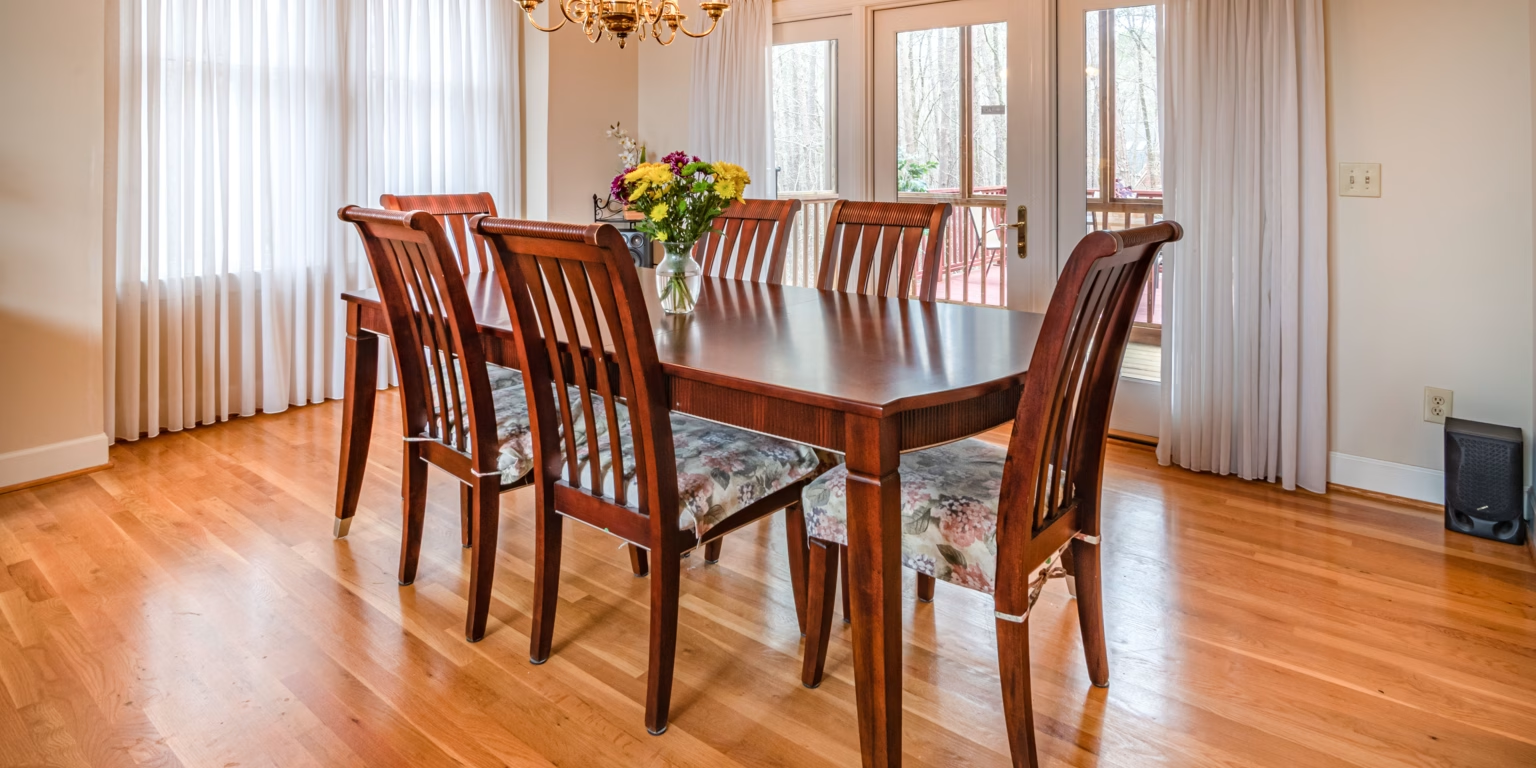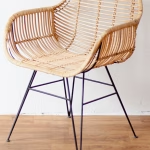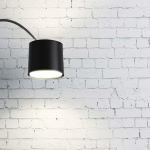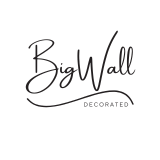The dining table is more than furniture; it’s the heart of the home. It’s where family and friends share meals and make memories. With many styles and sizes, picking the right table can be hard. This guide will help you find the perfect table for your home.
Choosing the Perfect Dining Table
Every home has a central spot, and for many, it’s the dining table. It’s where we share meals and celebrate. Choosing the right table is important. We’ll look at different types, what to consider, and how to style and care for your table.
Why a Dining Table Matters
A dining table is more than furniture; it’s a stage for life’s moments. It’s where families bond and friends gather. The right table adds comfort, style, and function to your home.
Understanding Different Types of Dining Tables
1. Traditional Dining Tables
Traditional tables are made of solid wood and have classic designs. They add warmth and character to any room.
Key Features
- Materials: Made from hardwoods like oak, cherry, or mahogany, they are durable and timeless.
- Design: They often have ornate carvings and rich finishes that enhance the look.
- Style: They fit well with classic, rustic, or farmhouse decor.
Pros and Cons of Traditional Dining Tables
- Pros: Durable, timeless, and adds warmth.
- Cons: May need more maintenance to keep the finish looking new.
2. Modern Dining Tables
Modern tables focus on simplicity and functionality. They have clean lines and various materials. They fit well in contemporary spaces.
- Materials: Made from tempered glass, metal, or engineered wood, they offer a sleek look.
- Design: They emphasize minimalism, often without ornate details.
- Style: They are perfect for modern or industrial homes.
Pros and Cons of Modern Dining Tables
- Pros: Easy to clean, visually striking, and often lightweight.
- Cons: Can feel cold or impersonal; some materials may scratch easily.
3. Extendable Dining Tables
Extendable tables are versatile, adjusting to your needs. They’re great for big gatherings without losing everyday use.
Key Features
- Mechanism: They can be extended using leaves or drop-down sections, ideal for small spaces.
- Functionality: Perfect for families or those who host often.
- Design: Available in both traditional and modern styles.
Pros and Cons of Extendable Dining Tables
- Pros: Versatile, space-saving, and practical for entertaining.
- Cons: May require assembly; can be less stable when extended.
4. Round Dining Tables
Round dining tables are great for small spaces. They make your dining area cozy and perfect for talking.
Key Features
- Space-Saving: Perfect for tight spots, allowing for flexible seating.
- Design: Often has pedestal bases or multiple legs for support.
- Style: Comes in many materials and finishes, like rustic wood or sleek glass.
Pros and Cons of Round Dining Tables
- Pros: Encourages talking, easy to move around.
- Cons: Can’t seat as many people as rectangular tables.
5. Rectangular Dining Tables
Rectangular tables are popular for big dining rooms. They offer lots of room and a classic look.
Key Features
- Capacity: Can hold more people, great for families and parties.
- Versatility: Works in both formal and casual settings, fitting many decor styles.
- Style: Available in many designs, materials, and finishes.
Pros and Cons of Rectangular Dining Tables
- Pros: Spacious, good for big groups, versatile.
- Cons: May not fit in small rooms as well as round tables.
Factors to Consider When Choosing a Dining Table
1. Size and Space
Choosing the right dining table size is key. Think about these points:
- Room Dimensions: Measure your dining area to make sure the table fits well without being too big.
- Clearance: Leave at least 36 inches of space around the table for easy movement and chair placement. This lets guests move in and out of their seats easily.
Space Planning Tips
- Use painter’s tape to mark the table’s size on the floor. This helps you see how it will fit in the space.
- Think about your ceiling height; a big table in a small room can feel too much.
2. Shape
The table’s shape affects your dining space’s flow and function:
- Round Tables: Great for small spaces and make talking easy.
- Rectangular Tables: Best for big groups and fit well in narrow spaces.
- Square Tables: Good for small, intimate dining but can feel tight with more than four guests.
3. Material
The table’s material affects its durability, upkeep, and look. Common materials are:
- Wood: Adds warmth and can be refinished to keep it looking good. But, it needs regular care to avoid scratches and wear.
- Glass: Makes spaces feel bigger, but can get fingerprints and scratches.
- Metal: Durable and modern, but may not have wood’s warmth.
Choosing the Right Material for Your Lifestyle
- If you have kids or pets, pick materials that are easy to clean and last long.
- If looks matter, choose a material that matches your decor.
4. Style
The table’s style should match your home’s look. Think about your furniture and decor:
- Traditional: Classic wood designs with fancy details work well in traditional or transitional homes.
- Modern: Sleek lines and simple materials fit modern or industrial decor.
- Rustic: Distressed wood and farmhouse styles create a cozy, welcoming feel.
5. Functionality
Think about how you will use the dining table:
- Daily Use: Choose a durable material that can withstand everyday wear and tear.
- Special Occasions: An extendable table may be beneficial for hosting larger gatherings without taking up extra space when not in use.
- Multifunctional: Consider a table that can serve multiple purposes, such as a workspace or buffet during parties.
Tips for Testing Dining Tables
1. Sit Down and Assess Comfort
When shopping for a dining table, take the time to sit and assess:
- Height: Ensure the table is at a comfortable height for your dining chairs.
- Legroom: Check for adequate space under the table for comfortable seating.
2. Evaluate Stability
Gently shake the table to test its stability. A sturdy table should not wobble or move excessively when you shift your weight.
3. Review Construction Quality
Inspect the joinery and materials used in the construction. Look for tables with solid wood construction or high-quality finishes that ensure longevity.
Where to Buy Dining Tables
1. Furniture Stores
Local furniture stores offer the advantage of trying out tables in person. You can compare styles, materials, and prices directly, allowing you to make a more informed decision.
2. Online Retailers
Online shopping provides a vast selection, often with competitive prices. Be sure to read customer reviews and check return policies before making a purchase.
3. Custom Furniture Makers
Consider working with a custom furniture maker to design a table that perfectly fits your space and style. This option allows you to choose specific materials, dimensions, and finishes to match your vision.
Styling Your Dining Table
1. Table Settings
Creating a beautiful table setting can enhance the dining experience. Here are some tips for styling your table:
- Layering: Use table runners or placemats to add texture and color to your setting.
- Centerpieces: Incorporate flowers, candles, or decorative objects that reflect your personal style.
2. Seasonal Decor
Change your table decor with the seasons to keep things fresh and inviting. Consider using autumn leaves, winter greens, or spring blooms to reflect the time of year.
3. Personal Touches
Add personal elements like family heirlooms, travel souvenirs, or handmade items to make your table unique and meaningful.
Maintenance Tips for Dining Tables
1. Cleaning
Regular cleaning is essential to keep your table looking its best:
- Wood: Use a soft cloth and wood-safe cleaner; avoid excessive moisture that can damage the finish.
- Glass: Clean with a glass cleaner and microfiber cloth to avoid streaks and smudges.
- Metal: Wipe down with a damp cloth and dry immediately to prevent rust.
2. Protection
Use coasters, placemats, and tablecloths to protect the surface from scratches, heat damage, and spills.
3. Avoid Direct Sunlight
Position your dining table away from direct sunlight to prevent fading and warping over time. Consider using window treatments to control light exposure.
Conclusion
Choosing the perfect dining table is an essential decision that will enhance your dining experience and elevate your home decor. By considering factors such as size, shape, material, and style, you can find a table that meets your needs and complements your space. Take the time to explore different options, test out tables in person, and envision how each piece will fit into your home. With the right dining table, you’ll create a welcoming atmosphere for family and friends, making every meal a cherished occasion.






